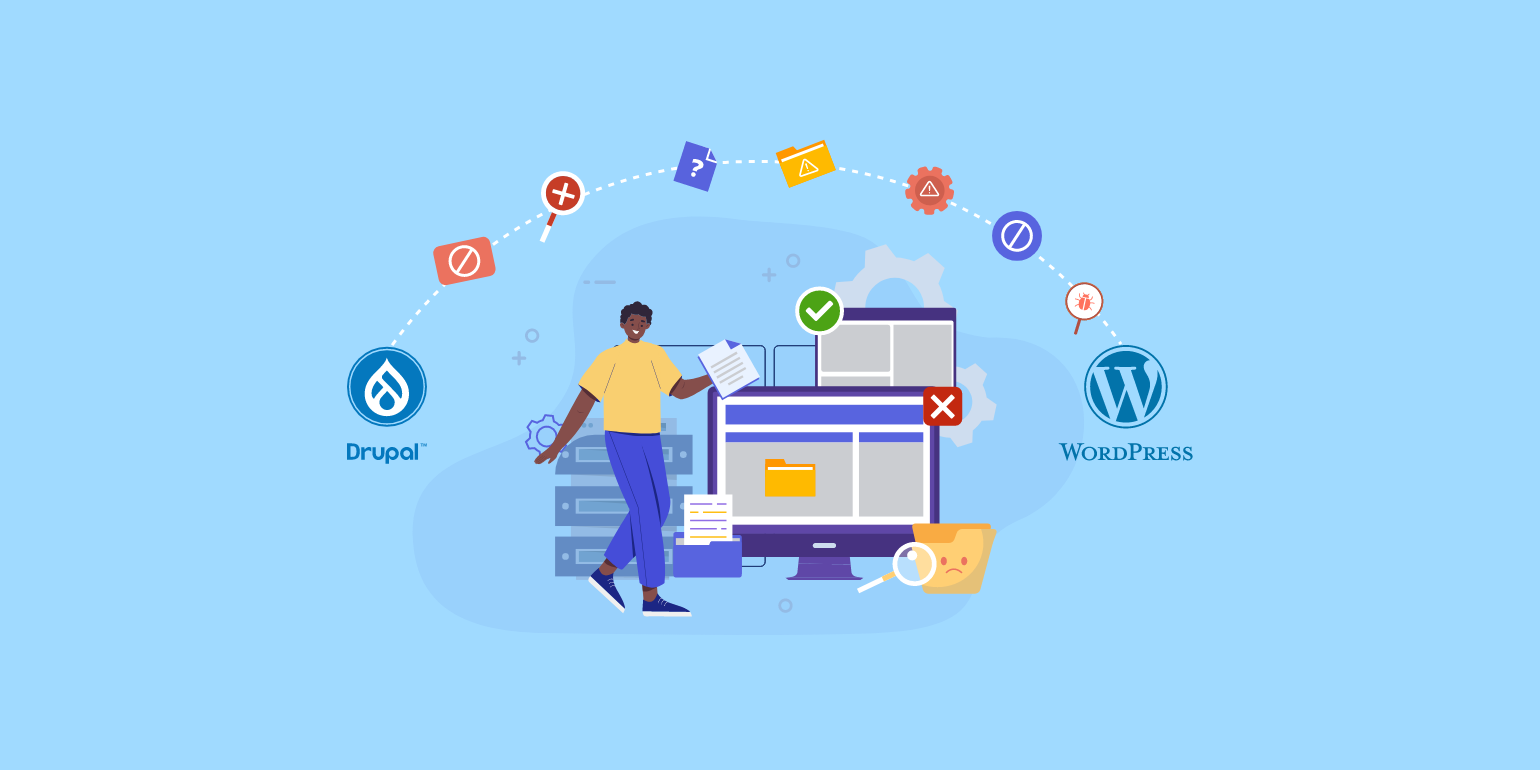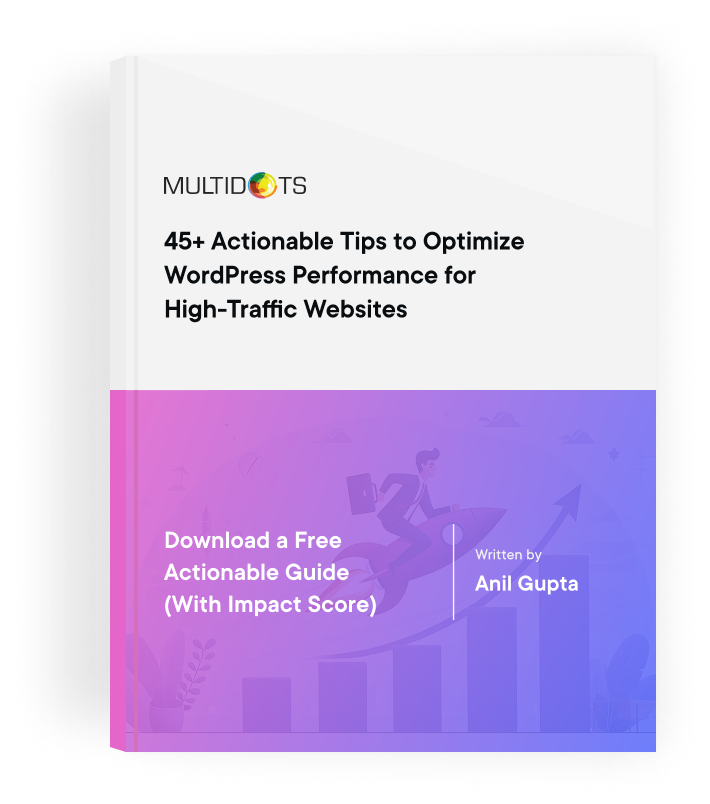7 Mistakes to Avoid When Migrating from Drupal to WordPress
Learn about the 7 common mistakes to avoid when migrating from Drupal to WordPress for a smooth and successful transition

Table of Contents
Making a shift from a legacy CMS like Drupal to WordPress isn't just trendy; it's almost necessary. WordPress comes with an intuitive interface and robust features that can supercharge your website’s functionality and user experience.
But migrating isn’t just about moving from point A to B. It’s about ensuring your website continues to run smoothly, your integrations remain functional, and your search engine rankings don’t plummet.
A small misstep during the migration can result in broken links, loss of content, or even data breaches. And the ripple effects of these can be hard to recover from. That’s why taking help from an experienced Drupal to WordPress migration services provider is often necessary to ensure a seamless and lossless transition for enterprise websites.
In this article, let’s look at the seven crucial Drupal to WordPress migration mistakes that you should steer clear of for a smooth and effective transition.
1. Inadequate Migration Planning
Migration from Drupal to WordPress is a complicated process that often requires taking your existing site offline or "freezing" it for some time. During this freeze, adding new content or making other updates isn't advisable because it can create data inconsistencies and complicate the migration further.
Failing to plan for this necessary downtime can disrupt your business operations and result in lost sales, deteriorated customer satisfaction, and a potentially damaged brand image.
Here are a few steps you can take to plan adequately for the migration:
- Back up all your Drupal site content. This can serve as a lifeline in case something goes awry.
- Migrate when your site traffic is low and have fewer business operations to run, like the holiday season.
- Inform your internal and external stakeholders well in advance about the Drupal to WordPress migration and expected downtime.
2. Lack of Content Mapping Strategy
Content mapping in the context of CMS migration — like moving from Drupal to WordPress — is about properly identifying, organizing, and transferring various types of content. This step ensures that the right piece of content lands in the right place, preserving the user experience and site functionality you've worked so hard to build.
In a Drupal to WordPress migration, a content mapping strategy could involve understanding how Drupal's content types, fields, and taxonomies correspond to WordPress's posts, custom fields, and categories.
Making this Drupal to WordPress migration mistake, you risk transferring content to wrong or undesired locations, leading to a confusing or even dysfunctional site.
Here are a few actionable tips that will help you map your content effectively:
- Audit Your Drupal Content to understand what you actually have to get a comprehensive view of what needs to be moved. Identify content types, associated fields, and any custom functionalities.
- Map Drupal Elements to WordPress Structure. For example, a Drupal "Article" might correspond to a WordPress "Post," and so on.
- Prioritize and Clean Up by getting rid of outdated or redundant content. Having less unnecessary data to migrate can simplify the process and make your new WordPress site more streamlined.
3. Not Prioritizing SEO
An improper migration can wreak havoc on your hard-earned Search Engine Results Page (SERP) rankings. Imagine losing visibility just when you were counting on attracting more traffic with your shiny new WordPress site!
Common pitfalls stemming from this Drupal to WordPress migration mistake that lead to this loss in rankings often revolve around not maintaining the URL structure, meta tags, and other SEO elements during the migration.
Sometimes, amidst the focus on design, content, and features, SEO gets left in the dust.
You can follow these actionable tips to mitigate these issues while migrating from Drupal to WordPress:
- Set up 301 redirects for all old URLs leading to their corresponding new ones in WordPress. This will help search engines understand the changes and pass the SEO value to the new pages.
- Migrate your meta titles and descriptions. These are the snippets that show up in search results, helping people decide whether to click on your link or not.
- Consult Your SEO Team or hire experts. They can identify any SEO-specific concerns that may not be apparent to the development team.
4. Neglecting Mobile Optimization
Google's mobile-first indexing and the ever-growing mobile user base make it clear: a website that's not optimized for mobile can be a liability from both SEO and business standpoints.
Migration offers its own set of challenges when it comes to mobile optimization. It's not uncommon to find heavy pages that load slowly, or unstructured data that makes navigation a headache on smaller screens.
Keep your mobile users happy during the migration with these WordPress optimization tips:
- Test on Multiple Devices. Make sure that the text is readable, the buttons are easily clickable, and the navigation is smooth.
- Compress images and minimize scripts to improve load speed. Large image files and heavy scripts can slow down your page loading times, which can be especially problematic for mobile users.
- Use a Mobile-Responsive WordPress Theme. This saves you the headache of manual adjustments and ensures a consistent experience across devices.
5. Overlooking Security Measures
An improperly migrated site could open doors to several vulnerabilities — such as weak default passwords or lack of HTTPS — that can lead to data corruption and theft.
Luckily, WordPress offers a suite of robust plugins designed to bolster your website's security and avoid this Drupal to WordPress migration mistake with ease.
For instance, plugins like Wordfence or Sucuri Security offer real-time firewall protection, malware scanning, and even advanced DDoS protection.
Another useful tool is iThemes Security, which provides over 30 ways to protect your site, including two-factor authentication and database backups.
You can better secure your site post-migration by following these tips:
- Change all default passwords for your admin, FTP, and database to complex, unique combinations.
- Enable HTTPS. If your Drupal site was already using HTTPS, make sure this carries over to your WordPress site. If not, now's a perfect time to enable it.
- Update your core software, themes, and plugins at regular intervals. Fortunately, WordPress’ constant updates include security patches that can secure your site even further.
6. Failing to Test Before Going Live
Releasing a website without adequate post-migration testing can lead to a host of problems, from broken links to features that don't work as they should. Imagine the frustration it can cause to your users and the negative impact it could have on your brand's reputation.
So what should you be testing? Look at these aspects for starters:
- Functionality: Are all the buttons, forms, and CTAs working?
- Content: Is all your content properly displayed, without broken links or formatting issues?
- Performance: Is your site's load time acceptable? Are there any issues with site speed?
Tools like Google's PageSpeed Insights or GTmetrix give you valuable data on your site's performance. For functionality and content issues, apps like Broken Link Checker can be very helpful.
Additionally, tools like BrowserStack allow you to test your website's compatibility across different browsers and devices.
Here are some actionable tips to ensure a smooth testing process:
- Conduct User Acceptance Testing. Use real-world scenarios to verify if your WordPress site meets business requirements.
- Check on multiple devices and operating systems. From smartphones to desktops and Android to Windows, make sure your site performs well on all device types.
- Use a staging environment that mimics your actual website before making the changes live.
7. Forgetting to Provide User Training
While both are content management systems, they have distinct user interfaces and operational procedures. For instance, Drupal's platform might be more developer-centric, while WordPress boasts a more user-friendly, intuitive dashboard.
Training your team can fast-track the adaptation process, making it easier for them to use the new CMS effectively right from the start. Better training means fewer errors and a more streamlined workflow — benefits you shouldn't overlook.
To get your team up to speed, here are some resources you should consider:
- Get Going Fast: A Checklist: For those already comfortable with digital tools, this straightforward guide covers all the basics.
- Create Your Site: Although your website is already created, this course will help you understand how to create new and modify existing pages and posts.
- Intro to SEO: Help your team understand the essentials of SEO, so your site can achieve optimal online visibility.
Other specialized resources worth checking out include Membership Sites 101 for managing subscription plans and Newsletters 101 for email engagement strategies. For those looking to start a blog or podcast, the Intro to Blogging and Intro to Podcasting courses can be invaluable.
Summing Up
Drupal to WordPress migration is a multifaceted process that requires meticulous planning, strategic content mapping, SEO preservation, mobile optimization, robust security measures, comprehensive testing, and adequate user training.
Missing out on any of these elements can result in disrupted operations, lost revenue, and even a compromised brand image.
For enterprises, the complexity involved in moving extensive databases, multiple user roles, and varied content types makes the process especially challenging. Mistakes not only cost time but can also lead to significant financial loss.
Multidots’ Drupal to WordPress migration services are designed to address all these challenges, providing you with a seamless transition experience without compromising on website functionality or user experience.
Contact us today and take the first step towards a seamless Drupal to WordPress migration experience.
FAQs
-
Importing a Drupal database to WordPress requires specialized tools or manual SQL queries which is crucial to map your Drupal content to corresponding WordPress fields. Consider hiring experts from reputed agencies like Multidots if it’s a large-scale migration.
-
Yes, the process involves transferring your content, users, and design elements. It’s a complex task but can be simplified by partnering with experienced Drupal to WordPress migration agencies like Multidots.
Feel free to schedule a quick call with our migration expert.
Contact Us
